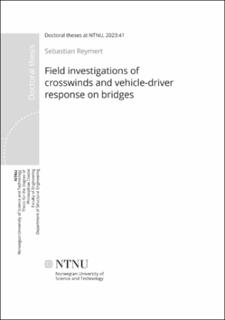| dc.contributor.advisor | Rønnquist, Anders | |
| dc.contributor.advisor | Øiseth, Ole Andre | |
| dc.contributor.author | Reymert, Sebastian | |
| dc.date.accessioned | 2023-03-23T09:13:09Z | |
| dc.date.available | 2023-03-23T09:13:09Z | |
| dc.date.issued | 2023 | |
| dc.identifier.isbn | 978-82-326-6117-6 | |
| dc.identifier.issn | 2703-8084 | |
| dc.identifier.uri | https://hdl.handle.net/11250/3060041 | |
| dc.description.abstract | There are currently no scientific, evidence-based guidelines for designing windrelated traffic regulations on Norwegian road bridges. The topic of crosswindexposed vehicles on bridges has been studied theoretically, numerically and in the lab, but not in the field. In this work, a test vehicle is established to take measurements of wind, vehicle and driver response in strong crosswinds. The aim is to identify and characterise gusts that cause drivers to perceive the vehicle as less stable and/or controllable.
Field measurements were taken under strong crosswinds (peak gust speeds between 20 and 32 m/s) on 7 different bridges – of which 4 are suspension bridges, 2 are cantilevered and 1 is cable-stayed – and 2 fixed-base roads in Norway. To the best knowledge, the data set is the first of its kind, with up to 40 repeated crossings at each location, utilising two-point satellite positioning, a 3-component accelerometer and gyroscope, an ultrasonic anemometer and measurements of driver steering input.
Predictable gusts are observed leeward of discrete obstacles to the crosswind such as towers, support piers, substantial structural components under the bridge deck or land at the abutments. It is found that gusts with certain spatial dimensions (1-4 vehicle lengths) and temporal periods (0.36-2 s) induce the most severe adverse handling responses. Stochastic gusts emanating from upstream terrain and the separation of flow over bluff-section bridge girders are found to continually perturb the vehicle-driver system and in some cases to cause front-axle skid events.
In general, it is found that decreasing the driving speed significantly decreases the severity of wind-induced handling motions. On the other hand, if large-scale, coherent vortex shedding is observed in the wake of the towers at a frequency that matches the vehicle’s natural roll frequency, then slow driving speeds allow excessive roll motions to develop. This can be a significant comfort issue.
The results allow infrastructure owners to design better mitigation strategies and ensure the safe crossing of vehicles whilst satisfying serviceability and cost requirements. Further research on mitigation strategies is needed, though the modulation of driving speed has been shown to effectively reduce the severity of handling response to wind perturbations. | en_US |
| dc.language.iso | eng | en_US |
| dc.publisher | NTNU | en_US |
| dc.relation.ispartofseries | Doctoral theses at NTNU;2023:41 | |
| dc.relation.haspart | Paper 1: Reymert, Sebastian; Rønnquist, Anders; Øiseth, Ole Andre. Systematic Metadata Analysis of Wind-Exposed Long-Span Bridges for Road Vehicle Safety Assessments. Journal of Bridge Engineering 2022 ;Volum 27.(2) s. -. Copyright © 2022 American Society of Civil Engineers. DOI: http://dx.doi.org/10.1061/(ASCE)BE.1943-5592.0001822. Chapter 4 in the thesis. | en_US |
| dc.relation.haspart | Paper 2: Sebastian Reymert, Anders Rønnquist, Ole Øiseth, Øyvind W. Petersen and Lars Drugge. Coupled vehicle-bridge-driver modelling of exposed long-span fjord crossings: an initial study. Bridge Maintenance, Safety, Management, Life-Cycle Sustainability and Innovations, Proceedings of the Tenth International Conference on Bridge Maintenance, Safety and Management (IABMAS 2020), Sapporo, Japan, 11-15 April, 2021, 3406-3414. ISBN: 9780429279119 Copyright © 2021 Taylor & Francis. Chapter 5 in the thesis. | en_US |
| dc.title | Field investigations of crosswinds and vehicle-driver response on bridges | en_US |
| dc.type | Doctoral thesis | en_US |
| dc.subject.nsi | VDP::Teknologi: 500 | en_US |
